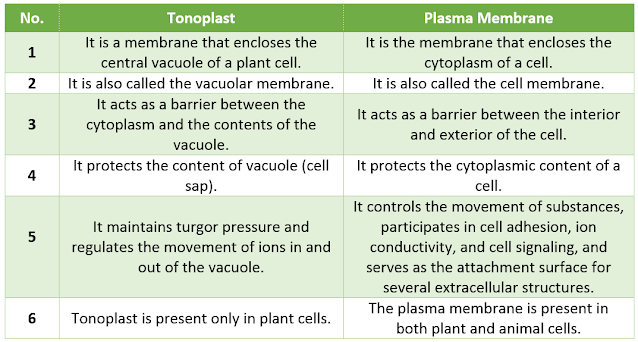Difference between tonoplast and plasma membrane is important to distinguish their location and function.
A cell is a structural and functional unit of life due to the division of labor among the different organelles it contains. The cell membrane separates the content of the cell from the outside environment by acting as a boundary. While tonoplast separates the liquid material called cell sap present in the vacuole from the rest of the cellular content.
If you compare the cell with a house then the cell membrane is the outer wall of the house while the tonoplast is the wall of the specific room.
Overall, both membranes are helping in compartmentalization, protection, cellular operations, and establishing the connection with their outside environment.
Note: An outside environment for tonoplast is the cytoplasm, while for cell membrane it is intercellular space.
What is tonoplast?
The vacuole is one of the most important intracellular constituents of a plant cell that occupies almost 90% of the total cell volume. Plant vacuole is a fluid-filled organelle in which enzymes, amino acids, proteins, metals, salts, pigments, and glucose molecules are present.
The vacuole is surrounded by a semi-permeable cytoplasmic membrane called tonoplast (also known as vacuolar membrane). The Tonoplast word is of Greek origin that is made up of two words “tonos”, meaning” “tension,” or “stretching, and “plastos” meaning “molded” or “formed”.
Thus, the tonoplast maintains the turgor pressure (the pressure exerted by the fluid or water on the membrane) as well as the passage of solutes in and out of vacuoles. Tonoplast is specifically found in plant cells.
What is a plasma membrane?
The cytoplasmic content of a cell including organelles, enzymes, hormones, amino acids, nucleic acids, metals, sugars, and lipids is protected by the outer covering called the plasma membrane.
This semi-permeable membrane is the outermost covering of an animal cell while it makes the second layer of the plant cell. The plasma membrane is also known as the cell membrane.
It is a lipid bilayer made up of phospholipids in which proteins, carbohydrates, and cholesterol are scattered. It performs various functions such as protection of the cell from external damage, movement of substances, maintenance of cellular composition, and sensing of external signals.
Difference between tonoplast and plasma membrane
Some key difference between tonoplast and plasma membrane have been recorded even though both are semipermeable membrane. Some of the differences are listed below.
|
No. |
Tonoplast |
Plasma Membrane |
|
1 |
It is a membrane that encloses the central vacuole of a plant cell. |
It is the membrane that encloses the cytoplasm of a cell. |
|
2 |
It is also called the vacuolar membrane. |
It is also called the cell membrane. |
|
3 |
It acts as a barrier between the cytoplasm and the contents of the vacuole. |
It acts as a barrier between the interior and exterior of the cell. |
|
4 |
It protects the content of vacuole (cell sap). |
It protects the cytoplasmic content of a cell. |
|
5
|
It maintains turgor pressure and regulates the movement of ions in and out of the vacuole. |
It controls the movement of substances, participates in cell adhesion, ion conductivity, and cell signaling, and serves as the attachment surface for several extracellular structures. |
|
6 |
Tonoplast is present only in plant cells. |
The plasma membrane is present in both plant and animal cells. |
The main difference between tonoplast and plasma membrane is that tonoplast is the cytoplasmic membrane that surrounds the central vacuole of a plant cell, while plasma membrane is the cell membrane that covers the cytoplasm of a cell.
Download image of difference between tonoplast and plasma membrane

|
|
Difference between tonoplast and plasma membrane |
Video lesson on Difference between Tonoplast and Plasma Membrane
Some questions and answers
1. Which membrane is known as tonoplast?
A. The cytoplasmic membrane that surrounds the central vacuole of a plant cell is known as tonoplast.
2. What is difference between tonoplast and vacuole?
A. A vacuole is a fluid-filled organelle present in the cytoplasm of a cell. On the other hand, tonoplast is the outer covering of a vacuole protecting the content of the vacuole from leakage.
3. Is tonoplast found in animal cell?
A. No, tonoplast is not found in the animal cell. It is specifically found in the plant cell.
4. What is the difference between tonoplast and plasma membrane?
A. Tonoplast is the cytoplasmic membrane that surrounds the central vacuole of a plant cell. The plasma membrane is the cell membrane that covers the cytoplasm of a cell.
5. Is the plasma membrane called the tonoplast?
A. No, the plasma membrane is a cell membrane covering the cytoplasmic content of a cell, while tonoplast is the outer covering of a vacuole.





0 Comments